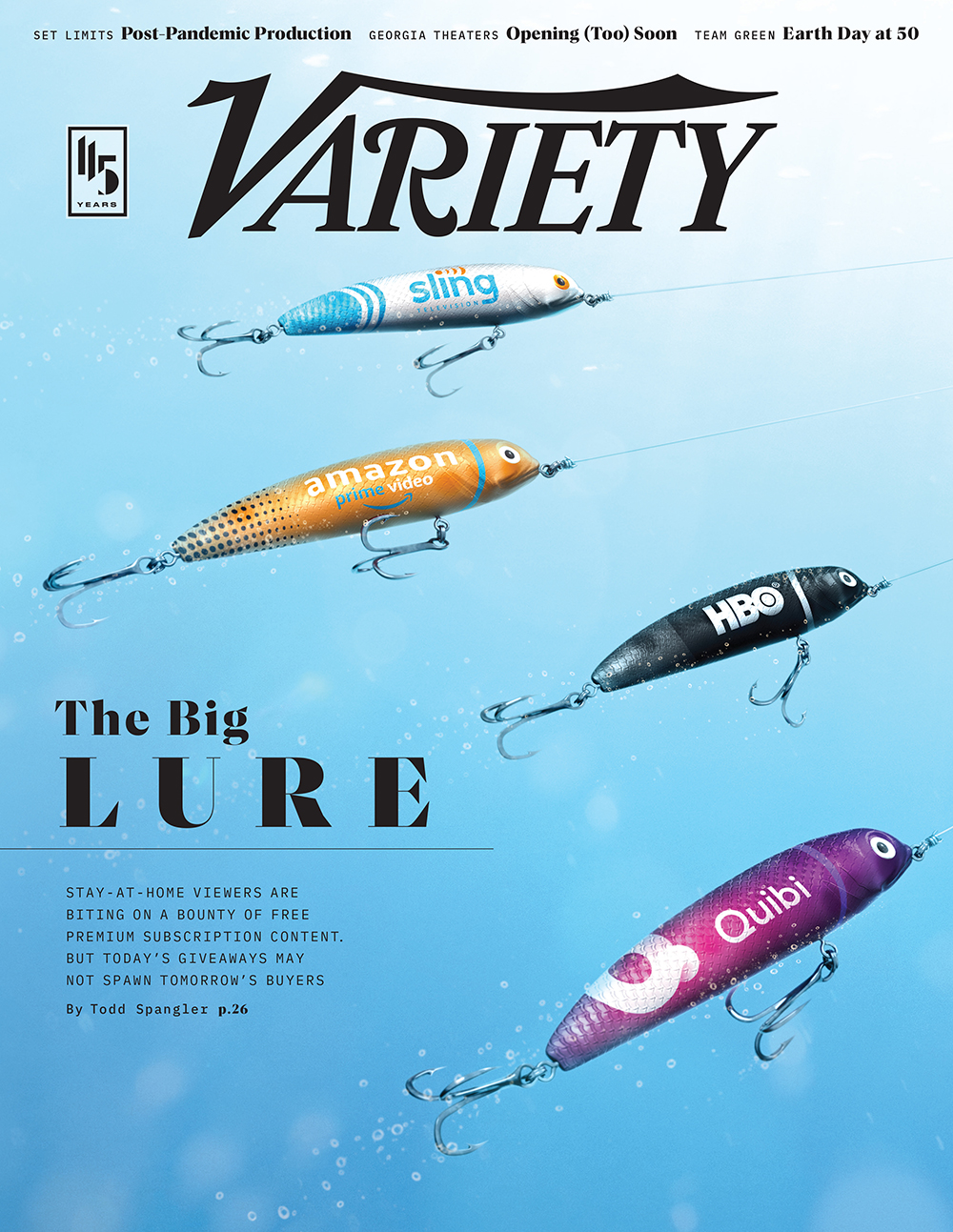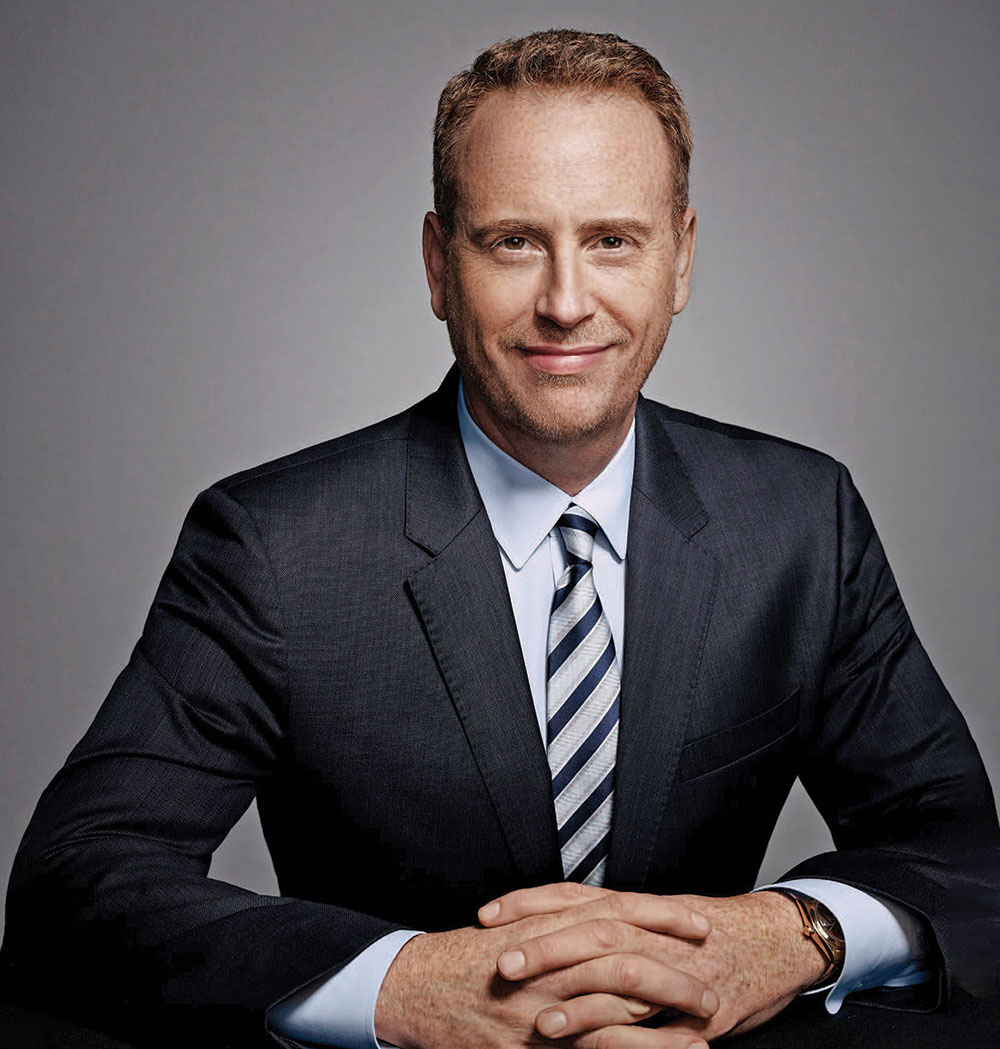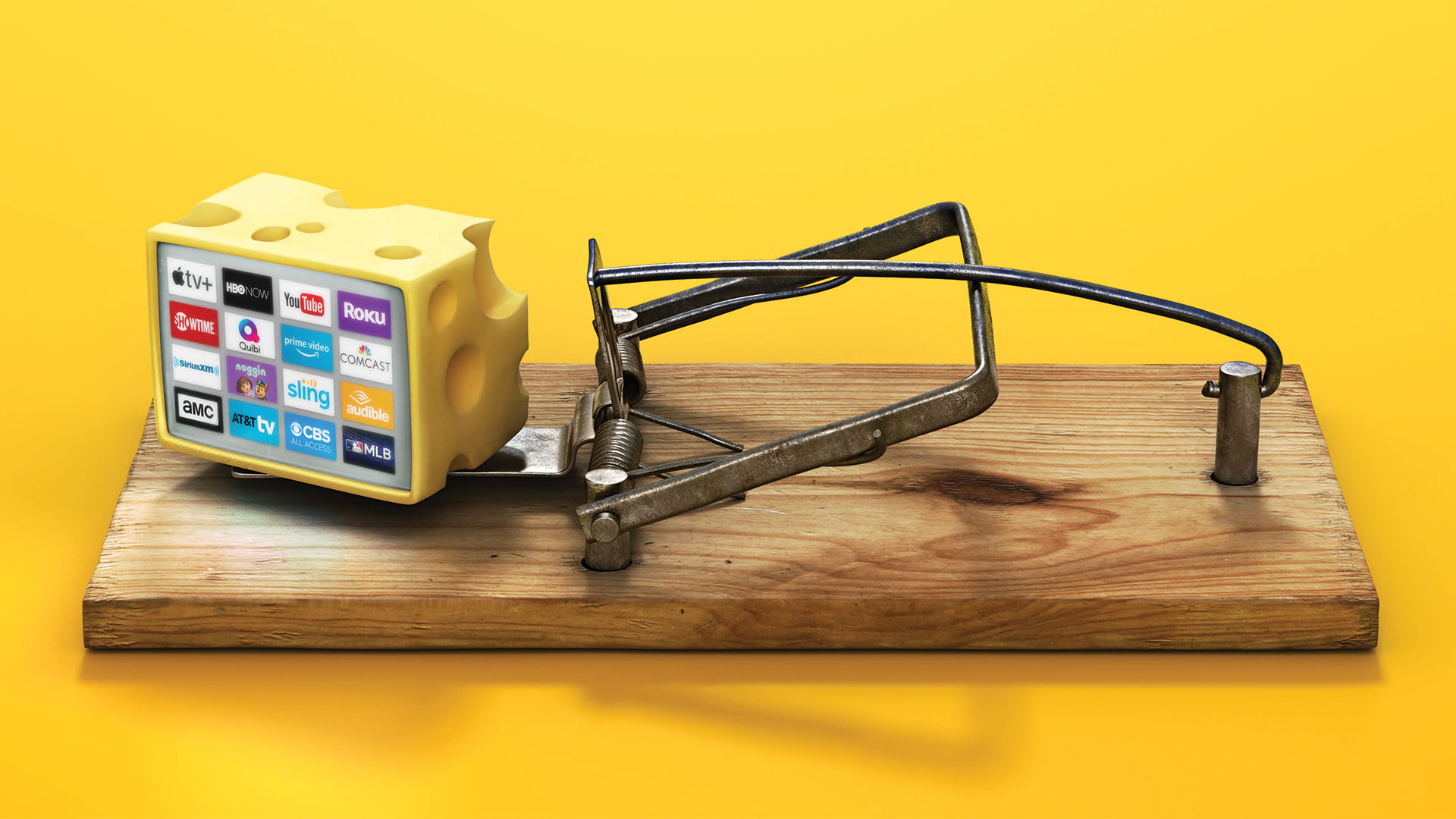Binge Bait: Will the Pandemic’s Free-Streaming Giveaways Net Paying Customers?
By Todd Spangler
LOS ANGELES (Variety.com) – Paywalls have crumbled during the COVID-19 crisis.
Call it the Great Pandemic Content Giveaway of 2020. But once consumers are suddenly asked to pay for programming that’s no longer complimentary, nobody’s really sure what the fire hose of free content will mean for the businesses that have scrambled to serve gratis access to their crown jewels.
The current quarantine has led dozens of companies, including HBO, Amazon, upstart Quibi, SiriusXM, Sling TV and Apple, to throw long-standing business rules about how to market high-value content out the window. Like many things during the pandemic, it’s uncharted territory.
In mid-March, the team in suburban Denver at Dish Network’s over-the-top service Sling TV began brainstorming about what to do in light of the coronavirus outbreak and the stay-at-home mandates keeping millions of people in the U.S. stuck indoors.
Warren Schlichting, Sling TV’s group president, says it started by loading up Sling’s already free ad-supported tier with additional content, including the ABC News Live channel and local Fox affiliates in 18 markets.
Then Sling decided to do something unprecedented in Dish’s history — it gave away one of its $30-per-month core live TV packages, with 45-plus channels, completely for free for two weeks in an offer good through April 5. It didn’t ask for any credit-card information or commitment, just an email address. Then Sling extended that offer for another seven days.
“Instead of starting from a business standpoint, we said, ‘What’s the right thing to do?’” says Schlichting. “It’s something we’re doing without much forethought or strategy.”
Now the OTT service is trying another novel tactic: Happy Hour Across America, which lets anyone in the U.S. with an internet connection watch more than 50 live TV channels for free from the hours of 5 p.m. to midnight, local time. The primetime-TV-for-free offer, also without any strings attached, kicked off April 14 and is set to run for a limited time. (By confining the free-viewing window to a seven-hour period, Sling will pay less to TV networks than if it offers a full 24-hour feed.)
Dish, like other pay-TV providers, has been steadily losing satellite customers for the past several years. The OTT Sling product is intended to help offset those losses, but in the fourth quarter, Sling dropped 94,000 subscribers, to 2.6 million total — the first time the streaming service ever posted a net decline in users. Last week, Dish disclosed that it plans to make layoffs across the company as it assesses the economic damage from COVID-19 but didn’t say how many employees would get pink-slipped.
Schlichting admits he doesn’t have a great read on the financial implications of Sling TV’s tearing down its paywall. And he’s uncertain how it will play with his results-oriented boss, Dish chairman Charlie Ergen, famous for no-holds-barred negotiations with content providers.
“I gotta tell you — I don’t know where this is going to land,” Schlichting says. Within the company, he adds, “we’re either going to win a lot of friends or get thrown off the end of the boat.”
Sling TV isn’t alone in unleashing free content without a clear idea what the upside might be. Through the end of April, WarnerMedia’s HBO is giving away streaming access to some 500 hours of premium content, including every episode of 10 original shows like “The Sopranos,” “Big Little Lies” and “Veep.” AMC Networks has unlocked premium content including the first half of “The Walking Dead” Season 10. Amazon has released dozens of kids TV shows and movies for free on Prime Video, including several PBS Kids favorites.
And Jeffrey Katzenberg’s Quibi, which debuted mid-pandemic on April 6, has gone out completely free for 90 days, while T-Mobile, its exclusive wireless partner, is bundling it for no extra charge on some unlimited plans for one full year (much like Disney Plus’ launch deal last November with Verizon). Quibi claims its app had 1.7 million downloads in the first week.
“I gotta tell you — I don’t know where this is going to land. We’re either going to win a lot of friends or get thrown off the end of the boat.”
Warren Schlichting, Sling TV
“We think it’s a moment in time that works on both sides,” Katzenberg tells Variety. “Hopefully it brings a little bit of happiness and lets people sample it under these circumstances” — and ideally, after the free promo period is over, the noshers will decide Quibi’s quick-bite lineup is worth paying for.
Quibi, which has banked $1.75 billion in funding, had its coming-out party at an inopportune time, to say the least. The service is built for on-the-go viewing — and the mobile-only design has frustrated some early adopters who would prefer to stream it on their HDTVs in our current stay-at-home world. The company is sticking to its small-screen mission, but says it’s fast-tracking development of a feature to “cast” streams to connected TVs.
Katzenberg claims he’s not concerned that Quibi isn’t generating subscriber fees right now. The company previously locked in $150 million in first-year advertising commitments. “It’s not something that is going to succeed or fail in 30 or 60 or 90 days,” the movie-mogul-turned-entrepreneur says. “Subscription businesses build over months and years.”
It’s no surprise that streaming has boomed during the quarantine, with U.S. viewing of internet video on TV up a whopping 109% in March 2020, according to Nielsen data. With a housebound population thirsty for diversion, subscription services are looking to gain mindshare by unlocking their gates for a limited time.
What happens post-pandemic? The streaming surge could spur Americans to shift more of their entertainment spending to OTT video as movie theaters and concert venues remain shuttered nationwide for the foreseeable future. On the other hand, the cornucopia of free TV shows, movies and other content may accelerate consumer expectations that they can watch a bunch of great stuff without paying for it.
HBO’s giant bucket of free programming — its biggest-ever release of content available without a subscription — is available through April 30. That leads up to the scheduled May 27 launch of HBO Max . Bob Greenblatt, chairman of WarnerMedia Entertainment and Direct-to-Consumer, claims the #StayHomeBoxOffice promotion was genuinely driven by a desire to help people get through COVID-19, not with an eye toward future market-share gains in the so-called streaming wars.
“We get that if more people watch this programming and warm to HBO Now, it may only help us down the road with HBO Max, but that wasn’t the main objective,” says Greenblatt. Rather, it was born out of the fact that “we were all grappling with the transition of sheltering and working from home.”
As for the content selection, Greenblatt says WarnerMedia wanted to provide “a solid mix of both classic series and recent hits” from HBO, as well as a collection of 20 movies from Warner Bros. focused on co-viewing opportunities for families with kids, with titles like “Pokémon Detective Pikachu” and “The Lego Movie 2: The Second Part.” Notably, HBO isn’t putting everything on the free sideboard, reserving TV tentpole franchises like “Game of Thrones” and “Westworld” for paying customers only.
We get that if more people watch this programming and warm to HBO Now, it may only help us down the road with HBO Max, but that wasn’t the main objective.
Bob Greenblatt, WarnerMedia
“I’m sure we’ll see engagement and tracking results when we get the data,” says Greenblatt, “but it wasn’t about metrics.”
HBO’s free-streaming move has perplexed some industry insiders. “It’s a goodwill gesture, sure,” says a senior executive at a video streaming service. “But are you more likely to subscribe to HBO Max because they did this? I don’t think so.” The downside, this exec suggests, is that the library titles HBO stocked in the all-you-can-eat free buffet are now devalued as lures to potential subscribers for HBO Max.
But others think there’s a major opportunity to capitalize on a large and suddenly captive audience.
Showtime Networks has expanded to 30 days the usual seven-day free trial for its standalone streaming service, until May 3. In the first three weeks of the promo, daily subscription sign-ups were two to three times the average, says chief operating officer Tom Christie. “We knew there were going to be a lot of people self-quarantined with not a lot to do except enjoy television,” he says. “Where we all kind of [agreed] was, maybe we can do well by doing good.”
Basic cable networks are also getting in on the watch-for-free action, but their options are more restricted than their pay-channel brethren because they have to stay within the strictures of their traditional distribution deals. For example, AMC Networks’ array of free stuff available without a cable subscription, in addition to the eight “Walking Dead” episodes, includes comedies from IFC, Sundance Now originals and nature documentaries from BBC America. But most of it is not first-window content — notably, current top AMC shows like “Killing Eve” and “Better Call Saul” are absent from the mix.
None of AMC’s free-streaming programming “contravenes any of our deals” with pay-TV partners, says Sarah Barnett, president of AMC Networks Entertainment Group and AMC Studios. “We had to talk to suppliers about putting some shows in front of the wall for free,” she says. Barnett thinks opening up the menu of free viewing options can only be a plus: “I can’t help coming back to the idea that people enjoying this content and really connecting with it can result in a good outcome.”
Pay-TV operators are also firing up collections of “ungated” content during the coronavirus quarantine.
Comcast launched a section in its TV guide called On the House While You’re in the House. More than 60 networks are providing free content on the cable giant’s Xfinity video services, ranging from educational programming to movies, including two dozen multicultural content partners. Since stay-at-home directives went into effect in March, Comcast has seen a 50% increase in voice-remote commands for “free movies.” Youth and adult education searches have soared sixfold, while viewing on premium networks like HBO, Showtime, Starz and Epix is up 30%, says Brynn Lev, VP of programming and editorial for Comcast Cable’s Xfinity X1 and Flex.
“This is simply a gift,” Lev says of the additional free content. “Every network I’m speaking with is doing this out of kindness and outreach to customers.”
The Quarantine Streaming Boom
U.S. video streaming to connected TVs in March 2020 more than doubled (up 109%) from a comparable four-week period a year ago.
AT&T also has opened free previews of premium channels — which has proved extremely popular. In the first week of the promotions (March 20-26), 40% of DirecTV customers who had channels added to their packages watched at least one of them. What’s more, that hasn’t hampered on-demand rentals and sales of movies: AT&T’s video-on-demand transactions the first week of April were up 90% compared with the week of March 2, according to the company, with continued strong performance from such titles as Universal’s “1917” and Disney/Lucasfilm’s “Star Wars: The Rise of Skywalker.”
The current environment clearly is leading more Americans to watch more video at home. And the uptick in video consumption, which was already on the rise, will continue to increase after the pandemic, says Rick Welday, AT&T’s exec VP and chief marketing officer for broadband and video.
“Behaviors are changing,” he says.
In a few cases, companies have tapped talent to announce free-streaming offers, a strategy designed to amplify the hype directly to the stars’ fan bases. Patrick Stewart, star of CBS All Access original “Star Trek: Picard,” announced a one-month free subscription to the service through April 23 for anyone in the U.S. SiriusXM enlisted Howard Stern to tout free access through May 15 to more than 300 streaming music, talk and news channels in North America.
“This is really wonderful news because I’m proud of our company,” Stern said on his March 31 program about SiriusXM’s largesse. “We’re opening it up to the people. It’s absolutely free.”
For subscription businesses, at a bare minimum the content giveaways can burnish their image. “That does have a halo effect on brands,” says Adriana Waterston, senior VP of Horowitz Research. She says the firm’s data shows consumers are more aware than ever of companies’ stance on social and political issues: “There’s the pro-social benefit of the companies saying, ‘We understand that you’re home and bored, and we’re here to help.’”
Not everyone is jumping into the free-for-all. Netflix and Hulu, for example, have not introduced any promos beyond their standard 30-day free trial offers. And Disney Plus, which offers a seven-day free trial, is doing substantial biz without having to resort to any special deals or ungated content.
Disney’s streaming service surpassed 50 million paying customers worldwide, the media giant announced April 8. That was buoyed by its recent launch in India — which in less than a week accounted for 8 million of those subs — and eight Western European countries. Disney Plus hit the milestone less than five months after its U.S. debut, far exceeding the company’s internal targets and Wall Street projections: The media conglomerate had told investors it expected somewhere between 60 million and 90 million sign-ups by 2024. There’s no doubt that the family-friendly streamer has benefited from the global coronavirus lockdown.
In March, U.S. consumers spent an average of $37 on streaming services, compared with $30 monthly in November 2019, according to a recent survey by Harris Poll commissioned by The Wall Street Journal. The biggest winner so far: Netflix, with 30% of people surveyed saying they signed up for an account with the SVOD leader last month.
But such a “quarantine bump” for subscription VOD players might be short-lived. Millions of Americans have lost their jobs as whole sectors of the economy have shut down. That could lead many to cancel premium services across the board.
“We still don’t know the long-term economic impact of all this,” Horowitz’s Waterston says.
Indeed, the tea leaves are mixed as to the business repercussions of all these giveaways: Among consumers who use internet streaming services, 21% had already canceled or were considering canceling at least one of their SVOD accounts, but 35% were thinking of or had already added or upgraded one or more of their streaming services, per a survey Horowitz fielded the week of March 30. In addition, 18% of cable/satellite subscribers said they had either already canceled or were considering canceling their service. Among cord-cutters, 19% were considering subscribing or had already recently subscribed to another TV service, the survey found.
Before the pandemic hit, consumers were hitting a wall in terms of the number of subscription-video services they were willing to pay for, says Integral Ad Science chief marketing officer Tony Marlow. An IAS study last month found 20% of those surveyed have added a paid streaming service during the COVID-19 crisis, while 44% said they’ve added a free streaming service.
“People’s appetite for free content has only exploded,” says Marlow. “And the most likely explanation is cost.”
Indeed, internet services with free ad-supported business models, like ViacomCBS’ Pluto TV and Tubi (which Fox Corp. is acquiring), are also experiencing a massive surge in activity from the quarantine-and-chill phenomenon.
Pluto TV has seen double-digit growth in daily active users during the pandemic, and, specifically, a 100% increase in viewing hours on news channels, says CEO Tom Ryan. Pluto had more than 22 million U.S. monthly active viewers as of the fourth quarter of 2019 and is growing overseas as well: The OTT service also has European versions and launched in 17 Latin American countries this month.
“Our platform is optimal for the current climate,” says Ryan, who has always asserted that Pluto TV is complementary to paid services: “While we all compete for eyeballs, Pluto is additive to any streaming bundle.” In the U.S., the service now streams more than 50,000 hours of free content. In early March, it brought back a 24-hour channel of James Bond movies, which broke its viewing records — until it launched a “Cops” channel on March 17, which set more new records, Ryan says.
With so much free content available, some subscription businesses feel the best way to attract prospective customers right now is by taking down the pay gate. That’s even with the understanding that they are forgoing the chance to net actual paying customers.
Sling TV’s Schlichting acknowledges that the service’s promos carry some opportunity cost — and, more than that, he says the division is incurring higher programming outlays without any corresponding revenue. “Yeah, this is not free to us,” he says.
But he’s wagering that the mass free-content experiments of the moment will yield financial upside at some point. “I hope it builds the brand, and people say, ‘Sling is so cool — I think I’ll give them try,’” Schlichting says. “It’s a leap of faith.”




